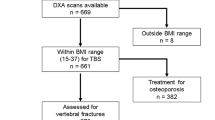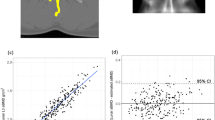Abstract
Summary
A retrospective case-control study assessing the association of DXA-derived 3D measurements with osteoporosis-related vertebral fractures was performed. Trabecular volumetric bone mineral density was the measurement that best discriminates between fracture and control groups.
Introduction
The aim of the present study was to evaluate the association of DXA-derived 3D measurements at the lumbar spine with osteoporosis-related vertebral fractures.
Methods
We retrospectively analyzed a database of 74 postmenopausal women: 37 subjects with incident vertebral fractures and 37 age-matched controls without any type of fracture. DXA scans at the lumbar spine were acquired at baseline (i.e., before the fracture event for subjects in the fracture group), and areal bone mineral density (aBMD) was measured. DXA-derived 3D measurements, such as volumetric BMD (vBMD), were assessed using a DXA-based 3D modeling software (3D-SHAPER). vBMD was computed at the trabecular, cortical, and integral bone. Cortical thickness and cortical surface BMD were also measured. Differences in DXA-derived measurements between fracture and control groups were evaluated using unpaired t test. Odds ratio (OR) and area under the receiver operating curve (AUC) were also computed. Subgroup analyses according to fractured vertebra were performed.
Results
aBMD of fracture group was 9.3% lower compared with control group (p < 0.01); a higher difference was found for trabecular vBMD in the vertebral body (− 16.1%, p < 0.001). Trabecular vBMD was the measurement that best discriminates between fracture and control groups, with an AUC of 0.733, against 0.682 for aBMD. Overall, similar findings were observed within the subgroup analyses. The L1 vertebral fractures subgroup had the highest AUC at trabecular vBMD (0.827), against aBMD (0.758).
Conclusion
This study showed the ability of cortical and trabecular measurements from DXA-derived 3D models to discriminate between fracture and control groups. Large cohorts need to be analyzed to determine if these measurements could improve fracture risk prediction in clinical practice.



Similar content being viewed by others
References
Johnell O, Kanis JA (2006) An estimate of the worldwide prevalence and disability associated with osteoporotic fractures. Osteoporos Int 17:1726–1733. https://doi.org/10.1007/s00198-006-0172-4
Ballane G, Cauley JA, Luckey MM, El-Hajj Fuleihan G (2017) Worldwide prevalence and incidence of osteoporotic vertebral fractures. Osteoporos Int 28:1531–1542. https://doi.org/10.1007/s00198-017-3909-3
Cummings SR, Melton LJ (2002) Epidemiology and outcomes of osteoporotic fractures. Lancet 359:1761–1767. https://doi.org/10.1016/S0140-6736(02)08657-9
Jalava T, Sarna S, Pylkka L et al (2003) Association between vertebral fracture and increased mortality in osteoporotic patients. J Bone Miner Res 18:1254–1259
Kanis JA (2002) Diagnosis of osteoporosis and assessment of fracture risk. Lancet 359:1929–1936. https://doi.org/10.1016/S0140-6736(02)08761-5
Kanis JA, Johansson H, Oden A, McCloskey EV (2009) Assessment of fracture risk. Eur J Radiol 71:392–397. https://doi.org/10.1016/j.ejrad.2008.04.061
Marshall D, Wedel H (1996) Meta-analysis of how well measures of bone mineral density predict occurrence of osteoporotic fractures. BMJ 312:1254–1259. https://doi.org/10.1136/bmj.312.7041.1254
Siris ES, Chen Y-T, Abbott TA, Barrett-Connor E, Miller PD, Wehren LE, Berger ML (2004) Bone mineral density thresholds for pharmacological intervention to prevent fractures. Arch Intern Med 164:1108–1112. https://doi.org/10.1001/archinte.164.10.1108
Dimai HP (2017) Use of dual-energy X-ray absorptiometry (DXA) for diagnosis and fracture risk assessment; WHO-criteria, T- and Z-score, and reference databases. Bone 104:39–43. https://doi.org/10.1016/j.bone.2016.12.016
Gordon CM, Lang TF, Augat P, Genant HK (1998) Image-based assessment of spinal trabecular bone structure from high-resolution CT images. Osteoporos Int 8:317–325. https://doi.org/10.1007/s001980050070
Genant HK, Wu CY, van Kuijk C, Nevitt MC (1993) Vertebral fracture assessment using a semiquantitative technique. J Bone Miner Res 8:1137–1148. https://doi.org/10.1002/jbmr.5650080915
Prevrhal S, Fox JC, Shepherd JA, Genant HK (2003) Accuracy of CT-based thickness measurement of thin structures : modeling of limited spatial resolution in all three dimensions. Med Phys 30:1–8. https://doi.org/10.1118/1.1521940
Li N, Li XM, Xu L, Sun WJ, Cheng XG, Tian W (2013) Comparison of QCT and DXA: osteoporosis detection rates in postmenopausal women. Int J Endocrinol 2013:1–5. https://doi.org/10.1155/2013/895474
Engelke K, Libanati C, Fuerst T, Zysset P, Genant HK (2013) Advanced CT based in vivo methods for the assessment of bone density, structure, and strength. Curr Osteoporos Rep 11:246–255. https://doi.org/10.1007/s11914-013-0147-2
Chalhoub D, Orwoll ES, Cawthon PM, Ensrud KE, Boudreau R, Greenspan S, Newman AB, Zmuda J, Bauer D, Cummings S, Cauley JA, Osteoporotic Fractures in Men (MrOS) Study Research Group (2016) Areal and volumetric bone mineral density and risk of multiple types of fracture in older men. Bone 92:100–106. https://doi.org/10.1016/j.bone.2016.08.014
Melton LJ, Riggs BL, Keaveny TM et al (2007) Structural determinants of vertebral fracture risk. J Bone Miner Res 22:1885–1892. https://doi.org/10.1359/jbmr.070728
Anderson DE, Demissie S, Allaire BT, Bruno AG, Kopperdahl DL, Keaveny TM, Kiel DP, Bouxsein ML (2014) The associations between QCT-based vertebral bone measurements and prevalent vertebral fractures depend on the spinal locations of both bone measurement and fracture. Osteoporos Int 25:559–566. https://doi.org/10.1111/j.1743-6109.2008.01122.x.Endothelial
Grampp S, Genant HK, Mathur A, Lang P, Jergas M, Takada M, Glüer CC, Lu Y, Chavez M (1997) Comparisons of noninvasive bone mineral measurements in assessing age- related loss, fracture discrimination, and diagnostic classification. J Bone Miner Res 12:697–711. https://doi.org/10.1359/jbmr.1997.12.5.697
Kopperdahl DL, Aspelund T, Hoffmann PF, Sigurdsson S, Siggeirsdottir K, Harris TB, Gudnason V, Keaveny TM (2014) Assessment of incident spine and hip fractures in women and men using finite element analysis of CT scans. J Bone Miner Res 29:570–580. https://doi.org/10.1002/jbmr.2069.Assessment
Wang X, Sanyal A, Cawthon P et al (2012) Prediction of new clinical vertebral fractures in elderly men using FEA of CT scans. J Bone Miner Res 27:808–816. https://doi.org/10.1002/jbmr.1539.Prediction
Zysset P, Qin L, Lang T, Khosla S, Leslie WD, Shepherd JA, Schousboe JT, Engelke K (2015) Clinical use of quantitative computed tomography–based finite element analysis of the hip and spine in the management of osteoporosis in adults: the 2015 ISCD official positions—part II. J Clin Densitom 18:359–392. https://doi.org/10.1016/j.jocd.2015.06.011
Imai K, Ohnishi I, Matsumoto T, Yamamoto S, Nakamura K (2009) Assessment of vertebral fracture risk and therapeutic effects of alendronate in postmenopausal women using a quantitative computed tomography-based nonlinear finite element method. Osteoporos Int 20:801–810. https://doi.org/10.1007/s00198-008-0750-8
Ahmad O, Ramamurthi K, Wilson KE, Engelke K, Prince RL, Taylor RH (2010) Volumetric DXA (VXA): a new method to extract 3D information from multiple in vivo DXA images. J Bone Miner Res 25:2744–2751. https://doi.org/10.1002/jbmr.140
Väänänen SP, Grassi L, Flivik G, Jurvelin JS, Isaksson H (2015) Generation of 3D shape, density, cortical thickness and finite element mesh of proximal femur from a DXA image. Med Image Anal 24:125–134. https://doi.org/10.1016/j.media.2015.06.001
Humbert L, Martelli Y, Fonolla R, Steghofer M, di Gregorio S, Malouf J, Romera J, Barquero LMDR (2017) 3D-DXA: assessing the femoral shape, the trabecular macrostructure and the cortex in 3D from DXA images. IEEE Trans Med Imaging 36:27–39. https://doi.org/10.1109/TMI.2016.2593346
Whitmarsh T, Humbert L, Del Río Barquero LM et al (2013) 3D reconstruction of the lumbar vertebrae from anteroposterior and lateral dual-energy X-ray absorptiometry. Med Image Anal 17:475–487. https://doi.org/10.1016/j.media.2013.02.002
López Picazo M, Magallón Baro A, del Rio Barquero LM et al (2018) 3D subject-specific shape and density estimation of the lumbar spine from a single anteroposterior DXA image including assessment of cortical and trabecular bone. IEEE Trans Med Imaging 37:2651–2662. https://doi.org/10.1109/TMI.2018.2845909
Humbert L, Hazrati Marangalou J, Del Río Barquero LM et al (2016) Technical note: cortical thickness and density estimation from clinical CT using a prior thickness-density relationship. Med Phys 43:1945–1954. https://doi.org/10.1118/1.4944501
Guglielmi G, Floriani I, Torri V, Li J, van Kuijk C, Genant HK, Lang TF (2005) Effect of spinal degenerative changes on volumetric bone mineral density of the central skeleton as measured by quantitative computed tomography. Acta Radiol 46:269–275. https://doi.org/10.1080/02841850510012661
Eswaran SK, Gupta A, Adams MF, Keaveny TM (2006) Cortical and trabecular load sharing in the human vertebral body. J Bone Miner Res 21:307–314. https://doi.org/10.1359/JBMR.051027
Roux JP, Wegrzyn J, Arlot ME, Guyen O, Delmas PD, Chapurlat R, Bouxsein ML (2010) Contribution of trabecular and cortical components to biomechanical behavior of human vertebrae: an ex vivo study. J Bone Miner Res 25:356–361. https://doi.org/10.1359/jbmr.090803
Chen H, Zhou X, Fujita H, Onozuka M, Kubo KY (2013) Age-related changes in trabecular and cortical bone microstructure. Int J Endocrinol 2013:1–9. https://doi.org/10.1155/2013/213234
Treece GM, Gee AH (2015) Independent measurement of femoral cortical thickness and cortical bone density using clinical CT. Med Image Anal 20:249–264. https://doi.org/10.1016/j.media.2014.11.012
Winzenrieth R, Humbert L, Di Gregorio S et al (2018) Effects of osteoporosis drug treatments on cortical and trabecular bone in the femur using DXA-based 3D modeling. Osteoporos Int 29:2323–2333
Van der Klift M, De Laet CE, McCloskey EV et al (2002) The incidence of vertebral fractures in men and women: the Rotterdam Study. J Bone Miner Res 17:1051–1056
Budoff MJJ, Khairallah W, Li D et al (2012) Trabecular bone mineral density measurement using thoracic and lumbar quantitative computed tomography. Acad Radiol 19:179–183. https://doi.org/10.1016/j.acra.2011.10.006
Noshchenko A, Plaseied A, Patel V et al (2013) Correlation of vertebral strength topography with 3-dimensional computed tomographic structure. Spine (Phila Pa 1976) 38:339–349
Jackman TM, Hussein AI, Adams AM, Makhnejia KK, Morgan EF (2014) Endplate deflection is a defining feature of vertebral fracture and is associated with properties of the underlying trabecular bone. J Orthop Res 32:880–886. https://doi.org/10.1002/jor.22620
Jackman TM, Hussein AI, Curtiss C, Fein PM, Camp A, de Barros L, Morgan EF (2016) Quantitative, 3D visualization of the initiation and progression of vertebral fractures under compression and anterior flexion. J Bone Miner Metab 31:777–788. https://doi.org/10.1002/jbmr.2749
Funding
We would like to acknowledge the support from the Industrial Doctorates program of the Generalitat de Catalunya, as well as the QUAES Foundation - UPF Chair for Computational Tools for Healthcare. The research leading to these results has also received funding from Programa Estatal de Investigación, Desarrollo e Innovación Orientada a los Retos de la Sociedad, Ministerio de Economía y Competitividad (Reference: RTC-2014-2740-1) and Eurostars program (Project ID: 9 140) funded by Centro para el Desarrollo Tecnológico Industrial, Ministerio de Economía Competitividad.
Author information
Authors and Affiliations
Corresponding author
Ethics declarations
Conflicts of interest
M. López Picazo is an employee of Galgo Medical. L. Humbert is a stockholder and employee of Galgo Medical. S. Di Gregorio, M. A. González Ballester and L. Del Rio have no conflict of interest.
Additional information
Publisher’s note
Springer Nature remains neutral with regard to jurisdictional claims in published maps and institutional affiliations.
Rights and permissions
About this article
Cite this article
López Picazo, M., Humbert, L., Di Gregorio, S. et al. Discrimination of osteoporosis-related vertebral fractures by DXA-derived 3D measurements: a retrospective case-control study. Osteoporos Int 30, 1099–1110 (2019). https://doi.org/10.1007/s00198-019-04894-y
Received:
Accepted:
Published:
Issue Date:
DOI: https://doi.org/10.1007/s00198-019-04894-y




